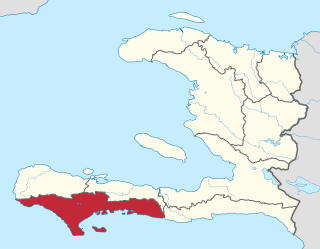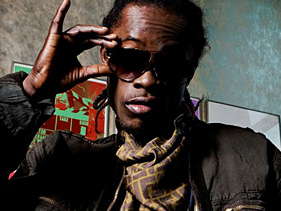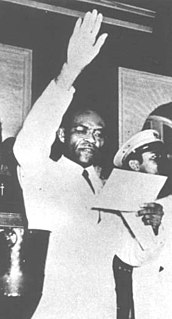
Cap-Haïtien often referred to as Le Cap or Au Cap, is a commune of about 190,000 people on the north coast of Haiti and capital of the department of Nord. Previously named, Cap‑Français and Cap‑Henri, it was historically nicknamed the Paris of the Antilles, because of its wealth and sophistication, expressed through its architecture and artistic life. It was an important city during the colonial period, serving as the capital of the French Colony of Saint-Domingue from the city's formal foundation in 1711 until 1770 when the capital was moved to Port-au-Prince. After the Haitian Revolution, it became the capital of the Kingdom of Northern Haiti under King Henri Christophe until 1820.

Nord-Ouest is one of the ten departments of Haiti as well as the northernmost one. It has an area of 2,102.88 km² and a population of 728,807. Its capital is Port-de-Paix.

Sud is one of the ten departments of Haiti. It has an area of 2,653.60 square kilometres (1,024.56 sq mi) and a population of 774,976. Its capital is Les Cayes.

Carrefour is a largely residential commune in the Port-au-Prince Arrondissement, in the Ouest department of Haiti. The commune had a population of 373,916 at the 2003 Census, and was officially estimated to have grown to 511,345 inhabitants in 2015. It is mostly a bedroom community for those who work in central Port-au-Prince.

The Université d'État d'Haïti (UEH) is one of Haiti's most prestigious institutions of higher education. It is located in Port-au-Prince.

Cité Soleil is an extremely impoverished and densely populated commune located in the Port-au-Prince metropolitan area in Haiti. Cité Soleil originally developed as a shanty town and grew to an estimated 200,000 to 400,000 residents, the majority of whom live in extreme poverty. The area is generally regarded as one of the poorest and most dangerous areas of the Western Hemisphere and it is one of the biggest slums in the Northern Hemisphere. The area has virtually no sewers and has a poorly maintained open canal system that serves as its sewage system, few formal businesses but many local commercial activities and enterprises, sporadic but largely free electricity, a few hospitals, and two government schools, Lycee Nationale de Cite Soleil, and Ecole Nationale de Cite Soleil. For several years until 2007, the area was ruled by a number of gangs, each controlling their own sectors. But government control was reestablished after a series of operations in early 2007 by the United Nations Stabilization Mission in Haiti (MINUSTAH) with the participation of the local population.

Kenscoff is a commune in the Port-au-Prince Arrondissement, in the Ouest department of Haiti, located in the foothills of the Chaîne de la Selle mountain range, some 10 kilometres to the southeast of the capital city of Port-au-Prince. The altitude is approximately 1500 meters, making the town the highest permanent settlement in the Caribbean. Because of its altitude, the temperature is on average cooler than the capital and during winter months can be chilly relative to the rest of the country. It has a population of around 52,200.

Pétion-Ville is a commune and a suburb of Port-au-Prince, Haiti, in the hills east and separate from the city itself on the northern hills of the Massif de la Selle. Founded in 1831 by then president Jean-Pierre Boyer, it was named after Alexandre Sabès Pétion (1770–1818), the Haitian general and president later recognized as one of the country's four founding fathers. The district is primarily a residential and touristic area. It held a population of 283,052 at the 2003 Census, which was officially estimated to have reached 376,834 in 2015. Many diplomats, foreign businessmen, and a large number of wealthy citizens do business and reside in Pétion-Ville.
Champ de Mars is a large public greenspace in Paris, France.

Adventist University of Haiti called in French:Université Adventiste d'Haïti is situated some five miles (8 km) southwest of Port-au-Prince, in the Carrefour neighborhood.

Port-au-Prince is an arrondissement in the Ouest department of Haiti. It had 2,109,516 inhabitants at the 2003 Census which was estimated to have risen to 2,759,991 in 2015 in an area of 735.78 sq km. Postal codes in the Port-au-Prince Arrondissement start with the number 61.
Hôpital de la Trinité was a hospital in Port-au-Prince, Haïti. It was operated by the Médecins Sans Frontières (MSF) which operates an emergency clinic at the hospital and in three other centers in the capital. It was where most of the injured from the 2008 Pétion-Ville school collapse were treated. The hospital was destroyed in the 2010 Haiti earthquake; medical treatment by MSF staff was subsequently moved to improvised tent facilities adjacent to the hospital building.

Jean Jimmy Alexandre, better known by his stage name Jimmy O, was a Haitian hip hop artist who was born in Port-au-Prince and lived in New York City. He was involved with Wyclef Jean's Yéle Haiti Foundation. Jimmy O performed his music in Haitian Creole.

The National Museum of Haiti in Port-au-Prince, Haiti, was completed in 1938. It is located at Route Nationale No. 1 in the neighborhood of Montrouis. It is not to be confused with the Musée du Panthéon National Haitien (MUPANAH), which is located across the street from the National Palace.

There are currently no functioning railways in Haiti and has never had any rail connections with the neighbouring Dominican Republic. However, between 1876 and about the 1970s, Haiti had various tramways and railways. A tram network operated in the capital, Port-au-Prince, between 1897 and 1932. Two railway lines, Port-au-Prince – Léogâne and Port-au-Prince – Manneville, along with some industrial lines, constituted the Haitian national rail network.
Haitian Carnival is a celebration held over several weeks each year leading up to Mardi Gras. Haitian Defile Kanaval is the Haitian Creole name of the main annual Mardi Gras carnival held in Port-au-Prince, Haiti.

The Exposition internationale du bicentenaire de Port-au-Prince was a world's fair held in Port-au-Prince, Haiti in 1949 to mark 200 years since Port-au-Prince's foundation.
The Port-au-Prince Haiti Temple is a temple of The Church of Jesus Christ of Latter-day Saints under construction in the Port-au-Prince suburb of Pétionville, Haiti. It is located adjacent to an existing meetinghouse at the intersection of Route de Frères and Impasse Saint-Marc.























